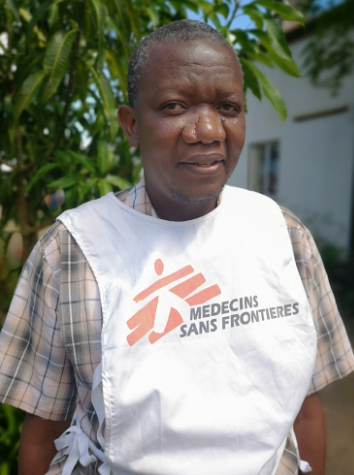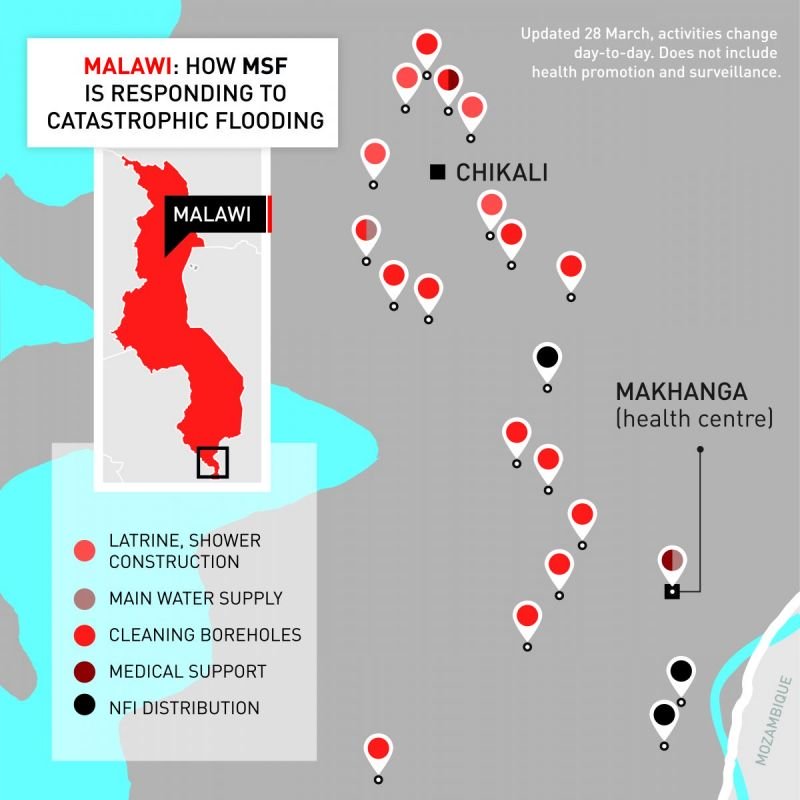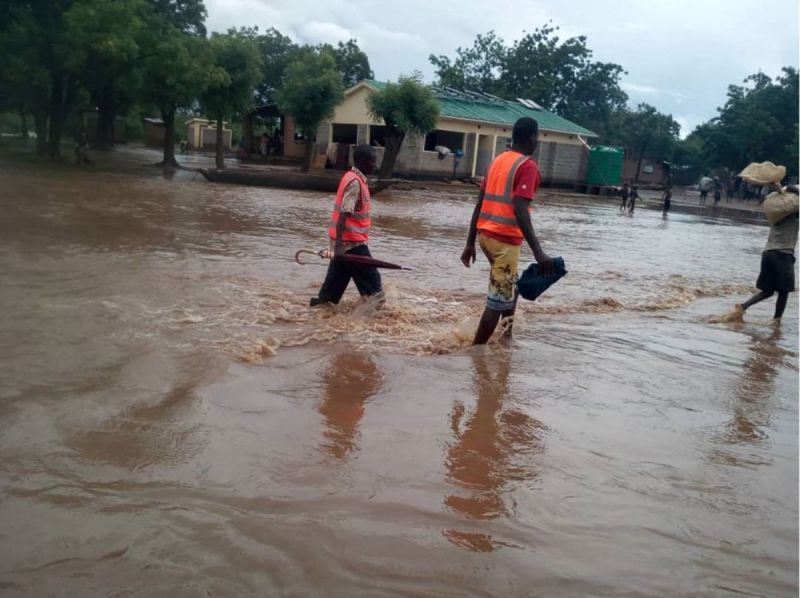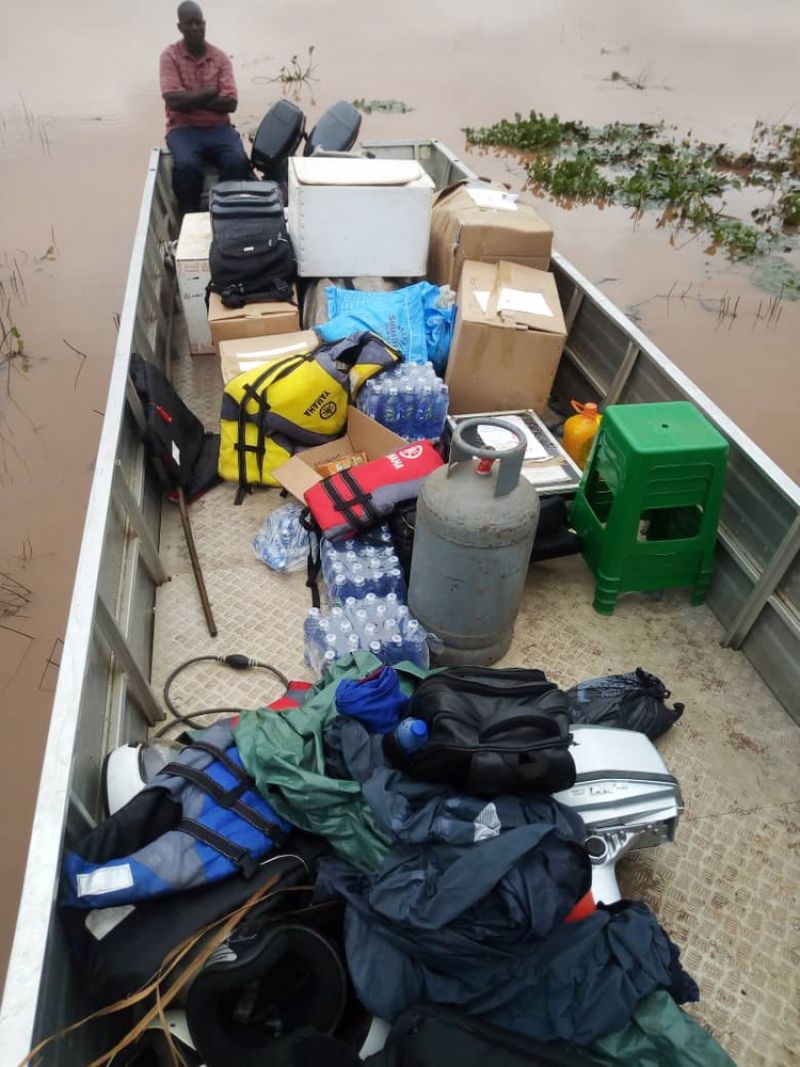In the heavy rains that preceded Cyclone Idai, a broad swathe of southern Malawi was submerged by flood waters. At least 60 people have died, and tens of thousands were made homeless. But things could have been much, much worse. Understanding how affected communities took steps to protect themselves, sometimes long before the waters rose, is key to understanding how to mitigate the impact of extreme weather events in the future. In the stories of these villages lie the lessons that southern Africa must learn if it is to have any chance of coping with climate change.
By Simon Allison in Ndamera and Chikali
Part 1: Thaundi
With the luxury of hindsight, we know that Biasi was in the middle of the heavy storm that would leave much of southern Malawi underwater. The storm then headed out into the Indian Ocean, where it gathered energy, returning as Cyclone Idai to pulverise Beira and surrounding provinces in both Mozambique and Zimbabwe.
Edward Biasi has been Thaundi’s headman since 1978. He thinks the village is now too dangerous for people to inhabit.
Among Biasi’s many responsibilities is reacting to extreme weather warnings. Knowing how to respond is never easy. Evacuating means abandoning the maize and bean crops, which were weeks away from harvest, and this year was on track to be a good one. Without that food, the village cannot eat. It also means leaving livestock to their certain deaths.
Nonetheless, he made his decision quickly. Bitter experience has taught him the value of caution. It was time to pack up and go.
This is not the first time he has had to make such a difficult call. Biasi has been headman since 1978, when he took over from his grandfather. He cannot remember how many times Thaundi has had to be evacuated, but he does know that it is happening far more often than before. The last major flood in southern Malawi was just four years ago, in 2015, in which at least 176 people were killed. “In my village we always get flooded. But it’s different from the past. It would happen once every ten years, and the waters weren’t so high. Now it’s more frequent.”
After each disaster, with increasing reluctance, he returns home. “We keep going back because we can’t have land anywhere else.”
Five chiefs report to Biasi, and at around 10pm he spoke with them about the impending disaster. They did not have a formal, sit-down discussion - there simply wasn’t time. Preparations to leave began immediately, and by 8am the next morning the first canoes were crossing the river, heading to the relative safety of Ndamera, a larger village on higher ground on the other side of the river. Ndamera has for decades offered refuge when the waters come.
There was no room for people to bring much in the way of belongings - just the clothes on their backs and maybe a few pots and pans - and all the goats, chickens, and guinea fowl had to be left behind.
Not everybody heeded the call to evacuate. “Most left, but some stayed,” said Biasi. “Sometimes people are not sure, they think the water is not moving so fast. But this time they were wrong.”
Never a bluegum
In times of great calamity, the smallest details can be the difference between life and death. What saved Nessie and her family’s life was the knowledge that bluegum trees become slippery when wet. Mango trees, however, retain their grip.
After two days spent clinging to a mango tree, a fisherman arrived in a dugout canoe to rescue Nessie and her family.
She strapped her two-year-old daughter to her back with a fold of chitenge. Her husband took their seven-year-old son. They looked for a suitable mango tree - never a bluegum - and clambered up.
And then they waited, watching as the water rose until their house and all their belongings were totally submerged. For two long days and longer nights they waited, but no one came to their rescue. While she waited, Nessie could not stop thinking about what happened to another woman in her village, in the 2015 floods. This woman, also stuck in the high branches of a tree, collapsed with exhaustion and fell into the water below. Neither her nor her baby survived. Even now, with Nessie’s baby giggling safely on dry land, this is all she can think about. “I keep imagining what would happen if I fell into the water and what would happen then.”
She didn’t get much sleep on the tree. “There were times when I dozed off, but I would wake up every few minutes. We were so hungry. The baby was so hungry that she was biting my arm.” Eventually, a fisherman rowed up in a dugout canoe, searching for survivors. Rescue came at a price - 1000 Kwacha (R20) per person - but the family was in no position to bargain.
The fisherman rowed them to a makeshift port on the east bank of the river, where they waited for another two days with no blankets or mosquito nets, and only a few handfuls of food, until word came from their chief to join the rest of the village in Ndamera. “This time, it’s better than in 2015. This time no one from our village died,” said Nessie.
Even my laugh is weak
Joel Kadalinga, 47, saw trouble coming - years ago. After the 2015 floods, he saved up to build a house in Ndamera. “Our area is a flood and famine area. One year I got the money and I moved. It’s very safe here because it’s up.” Him and his family still live and farm in Thaundi. They grow maize to eat, and beans and sugar cane to sell. But at the first hint of floods to come, they escape to Ndamera, only a couple of hours away in normal times, to wait it out. This year they moved in January, just in case, and when the river began to rise in Thaundi they were already in a fully-equipped place of safety.
“It was hard for the village to sense that this was a dangerous situation,” he said. “The weather these days is unpredictable. It was only when the water was up to their necks that they moved.”
Months before the floods, Joel Kadalinga moved his family to another village at a higher elevation.
There is only so much anyone can do, however. Although all the new arrivals have some form of temporary accommodation and the children have been welcomed into the local school, food remains scarce. Rations provided by government and humanitarian agencies are just two cups of maize meal per family per day. For the rest of their diet, the men go out to hunt or fish or forage, or try to pick up piece work in unaffected communities. It is never enough. “I’m so hungry that even my laugh is weak,” said Nessie.
Kadalinga is even more worried about what happens when the flood waters recede, and the villagers of Thaundi return home. “Three months from now, we will go back. We will continue with our yearly activities. All the moisture in the soil means that the next harvest will be excellent, but we have to survive until then. We need support to do so.” And then? “We are worried. It’s tiresome. We build our homes and then two or three years later they are destroyed.”
For Biasi, the Thaundi headman, there is no small measure of pride that he made the right decision. Despite the devastation of their homes, no one from Thaundi died in the floods. No one was injured. But he knows, if the weather continues to behave so erratically, that there will be a next time. “I don’t think the village will still be there in 50 years. I don’t think anyone should live there now. But that’s the only land that we have, so what choice have we got? It’s very painful for me and my people, but we have no choice.”
Part 2: Chikali
In Chikali village, also on the west bank of the Shire River, very near the border with Mozambique, memories of the last great flood are fresh. It was only four years ago, in 2015, and ten people from the village were killed. Markson Beka remembers it well: the waters rose at night, and it was chaos as people ran around in panic, not knowing what to do or where to go.
This time, when the floods came, the village reacted totally differently. Despite 1799 households in Chikali and the surrounding area being affected, there were no casualties. Not one. “It’s because of the awareness we created. We told people to move in time. We had a plan,” said Beka.
Markson Beka’s Village Civil Protection Committee learnt from the mistakes made during the 2015 floods.
The committee learned from the mistakes made in 2015, and put in place procedures to prepare for the next disaster, and to mitigate its impact.
The first step was to train residents to recognise the warning signs. “When we see more ants, that is a sign that more rains are coming. When we have continuous days of rain, then we can expect a flood,” said Beka.
Next the committee created assembly points on higher ground, so that people would know exactly where to go when they sensed trouble. This is not an option for all villages, but Chikali is lucky in that it is relatively hilly, and some areas are safe from floods.
The committee toured around all the low-lying settlements to ensure that everyone knew what to do when disaster struck.
Before the floods, this plot, now entirely bare, was occupied by five or six houses.
The significance of the whistles cannot be overstated, he said. Not only does the whistle serve as an alarm bell, it also allowed committee members to easily direct nervous crowds to places of safety. Again, in an emergency, it is the smallest details that can make the difference between life and death.
Once the waters have gone, and things return to normal, Enelisi Wiseman intends to ask the chief for a house on higher ground
Enelisi Wiseman was among those affected. When the whistles sounded, her and her family knew what to do. “When the disaster happened we were in our village. We then moved into the primary school.” Several days later, the village headman allocated land for her and 114 other households to construct temporary accommodation while they wait for the flood waters to recede. The new accommodation is already being built: reed huts to replace the clay-brick houses.
Around the village, at least in the areas where the waters have receded, the ruins of the houses that were destroyed are obvious in the collapsed walls and the piles of tumbled-down bricks; and in the patches of bare earth where even foundation stones were ripped from the ground.
Brains Kamanula, a community health worker with Doctors Without Borders.
Food remains a problem, however. The area is accessible only by boat, which makes it hard for humanitarian organisations to get there. Everyone’s crops have been decimated by the storms and the floods, and what little is left is being strictly rationed.
It could be several months until Wiseman and her family return home. When they gets there she will have to start again from scratch. She knows that hers is not a sustainable lifestyle in the long-term, that something has to change. “We have a tentative solution that we have discussed amongst ourselves,” she said. “We are desperate so we will go back and build temporary houses and go and plant our crops. After we harvest, we will go and ask the chief if we can have some land somewhere higher up.” This time she escaped with her life, and she doesn’t want to have to do it again.
(Photographs: Simon Allison)
http://atavist.mg.co.za/the-malawian-villages-that-took-on-the-floods-and-survived?fbclid=IwAR1kLik0FdDfux07fXgDCDXBNKYQDm8xAffvpKxc1d44iHBcXlRAgapeaxk








